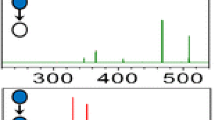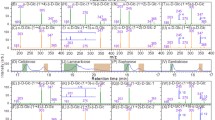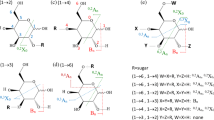Abstract
Carbohydrates play important roles in biological recognition processes. However, determining the structures of carbohydrates remains challenging because of their complexity. A simple tandem mass spectrometry-based method for determining the structure of underivatized mannose tetrasaccharides was demonstrated. This method employed the multistage low-energy collision-induced dissociation (CID) of sodium adducts in an ion trap, a logically derived sequence (LODES) from the dissociation mechanism for deciding the sequence of CID, and a specially prepared disaccharide spectrum database. Through this method, the linkages, anomeric configurations, and branch locations of carbohydrates could be determined without the prior assumption of possible structures. We validated this method by blind test of all the commercial available mannose tetrasaccharides. We showed that the structure of a given tetrasaccharide can be determined from 928 isomers by using only three to six appropriately selected CID mass spectra according to the proposed procedure. This method is simple and rapid and has the potential to be applied to other hexoses and oligosaccharides larger than tetrasaccharides. The CID procedures can be built in a computer-controlled mass spectrometer for automatic structural determination of underivatized oligosaccharides.

Graphical abstract










Similar content being viewed by others
References
Essentials of glycobiology. 3rd ed. New York: Cold Spring Harbor Laboratory Press; 2017.
Council NR. Transforming glycoscience: a roadmap for the future. Washington, DC: The National Academies Press; 2012.
Laine RA. A calculation of all possible oligosaccharide isomers both branched and linear yields 1.05x10(12) structures for a reducing hexasaccharide - the isomer-barrier to development of single-method saccharide sequencing or synthesis systems. Glycobiology. 1994;4(6):759–67.
Zaia J. Mass spectrometry of oligosaccharides. Mass Spectrom Rev. 2004;23(3):161–227.
Kailemia MJ, Ruhaak LR, Lebrilla CB, Amster IJ. Oligosaccharide analysis by mass spectrometry: a review of recent developments. Anal Chem. 2014;86(1):196–212.
Hofmeister GE, Zhou Z, Leary JA. Linkage position determination in lithium-cationized disaccharides - tandem mass-spectrometry and semiempirical calculations. J Am Chem Soc. 1991;113(16):5964–70. https://doi.org/10.1021/ja00016a007.
Asam MR, Glish GL. Tandem mass spectrometry of alkali cationized polysaccharides in a quadrupole ion trap. J Am Soc Mass Spectrom. 1997;8(9):987–95.
Costa EV, Moreira ASP, Nunes FM, Coimbra MA, Evtuguin DV, Domingues MRM. Differentiation of isomeric pentose disaccharides by electrospray ionization tandem mass spectrometry and discriminant analysis. Rapid Commun Mass Spectrom. 2012;26(24):2897–904.
Zhang H, Brokman SM, Fang N, Pohl NL, Yeung ES. Linkage position and residue identification of disaccharides by tandem mass spectrometry and linear discriminant analysis. Rapid Commun Mass Spectrom. 2008;22(10):1579–86.
Xue J, Song LG, Khaja SD, Locke RD, West CM, Laine RA, et al. Determination of linkage position and anomeric configuration in Hex-Fuc disaccharides using electrospray ionization tandem mass spectrometry. Rapid Commun Mass Spectrom. 2004;18(17):1947–55.
Harvey DJ. Fragmentation of negative ions from carbohydrates: part 2. Fragmentation of high-mannose N-linked glycans. J Am Soc Mass Spectrom. 2005;16(5):631–46.
Harvey DJ. Fragmentation of negative ions from carbohydrates: part 1. Use of nitrate and other anionic adducts for the production of negative ion electrospray spectra from N-linked carbohydrates. J Am Soc Mass Spectrom. 2005;16(5):622–30.
Ashline D, Singh S, Hanneman A, Reinhold V. Congruent strategies for carbohydrate sequencing. 1. Mining structural details by MSn. Anal Chem. 2005;77(19):6250–62.
Zhang HL, Singh S, Reinhold VN. Congruent strategies for carbohydrate sequencing. 2. FragLib: an MSn spectral library. Anal Chem. 2005;77(19):6263–70.
Singh C, Zampronio CG, Creese AJ, Cooper HJ. Higher energy collision dissociation (HCD) product ion-triggered electron transfer dissociation (ETD) mass spectrometry for the analysis of N-linked glycoproteins. J Proteome Res. 2012;11(9):4517–25.
Both P, Green AP, Gray CJ, Šardzík R, Voglmeir J, Fontana C, et al. Discrimination of epimeric glycans and glycopeptides using IM-MS and its potential for carbohydrate sequencing. Nat Chem. 2013;6:65.
Tan Y, Polfer NC. Linkage and anomeric differentiation in trisaccharides by sequential fragmentation and variable-wavelength infrared photodissociation. J Am Soc Mass Spectrom. 2015;26(2):359–68.
Lee S, Valentine SJ, Reilly JP, Clemmer DE. Analyzing a mixture of disaccharides by IMS-VUVPD-MS. Int J Mass Spectrom. 2012;309:161–7.
Yu X, Jiang Y, Chen YJ, Huang YQ, Costello CE, Lin C. Detailed glycan structural characterization by electronic excitation dissociation. Anal Chem. 2013;85(21):10017–21.
Witze ES, Old WM, Resing KA, Ahn NG. Mapping protein post-translational modifications with mass spectrometry. Nat Methods. 2007;4(10):798–806.
Zhu ZK, Su XM, Clark DF, Go EP, Desaire H. Characterizing O-linked glycopeptides by etransfer dissociation: fragmentation rules and applications in data analysis. Anal Chem. 2013;85(17):8403–11.
Cancilla MT, Penn SG, Carroll JA, Lebrilla CB. Coordination of alkali metals to oligosaccharides dictates fragmentation behavior in matrix assisted laser desorption ionization Fourier transform mass spectrometry. J Am Chem Soc. 1996;118(28):6736–45.
Cancilla MT, Wang AW, Voss LR, Lebrilla CB. Fragmentation reactions in the mass spectrometry analysis of neutral oligosaccharides. Anal Chem. 1999;71(15):3206–18.
Stephens E, Maslen SL, Green LG, Williams DH. Fragmentation characteristics of neutral N-linked glycans using a MALDI-TOF/TOF tandem mass spectrometer. Anal Chem. 2004;76(8):2343–54.
Kurimoto A, Daikoku S, Mutsuga S, Kanie O. Analysis of energy-resolved mass spectra at MSn in a pursuit to characterize structural isomers of oligosaccharides. Anal Chem. 2006;78(10):3461–6.
Segu ZM, Mechref Y. Characterizing protein glycosylation sites through higher-energy C-trap dissociation. Rapid Commun Mass Spectrom. 2010;24(9):1217–25.
Azenha CSR, Coimbra MA, Moreira ASP, Domingues P, Domingues MRM. Differentiation of isomeric β-(1–4) hexose disaccharides by positive electrospray tandem mass spectrometry. J Mass Spectrom. 2013;48(5):548–52.
Yuan H, Liu L, Gu J, Liu Y, Fang M, Zhao Y. Distinguishing isomeric aldohexose-ketohexose disaccharides by electrospray ionization mass spectrometry in positive mode. Rapid Commun Mass Spectrom. 2015;29(22):2167–74.
Bythell BJ, Abutokaikah MT, Wagoner AR, Guan S, Rabus JM. Cationized carbohydrate gas-phase fragmentation chemistry. J Am Soc Mass Spectrom. 2017;28(4):688–703.
Rabus JM, Abutokaikah MT, Ross RT, Bythell BJ. Sodium-cationized carbohydrate gas-phase fragmentation chemistry: influence of glycosidic linkage position. Phys Chem Chem Phys. 2017;19(37):25643–52.
Guan B, Cole RB. MALDI linear-field reflectron TOF post-source decay analysis of underivatized oligosaccharides: determination of glycosidic linkages and anomeric configurations using anion attachment. J Am Soc Mass Spectrom. 2008;19(8):1119–31.
Harvey DJ, Jaeken J, Butler M, Armitage AJ, Rudd PM, Dwek RA. Fragmentation of negative ions from N-linked carbohydrates, part 4. Fragmentation of complex glycans lacking substitution on the 6-antenna. J Mass Spectrom. 2010;45(5):528–35.
Konda C, Bendiak B, Xia Y. Linkage determination of linear oligosaccharides by MSn (n > 2) collision-induced dissociation of Z1 ions in the negative ion mode. J Am Soc Mass Spectrom. 2014;25(2):248–57.
Viseux N, de Hoffmann E, Domon B. Structural assignment of permethylated oligosaccharide subunits using sequential tandem mass spectrometry. Anal Chem. 1998;70(23):4951–9.
Domon B, Mueller DR, Richter WJ. Tandem mass spectrometric analysis of fixed-charge derivatized oligosaccharides. Org Mass Spectrom. 1994;29(12):713–9.
Ruhaak LR, Steenvoorden E, Koeleman CAM, Deelder AM, Wuhrer M. 2-Picoline-borane: a non-toxic reducing agent for oligosaccharide labeling by reductive amination. PROTEOMICS. 2010;10(12):2330–6.
Costell CE, Contado-Miller JM, Cipollo JF. A glycomics platform for the analysis of permethylated oligosaccharide alditols. J Am Soc Mass Spectrom. 2007;18(10):1799–812.
Palma AS, Liu Y, Zhang H, Zhang Y, McCleary BV, Yu G, et al. Unravelling glucan recognition systems by glycome microarrays using the designer approach and mass spectrometry. Mol Cell Proteomics. 2015;14(4):974–88.
Hsu HC, Liew CY, Huang SP, Tsai ST, Ni CK. Simple approach for de novo structural identification of mannose trisaccharides. J Am Soc Mass Spectrom. 2018;29(3):470–80.
Hsu HC, Liew CY, Huang S-P, Tsai S-T, Ni C-K. Simple method for de novo structural determination of underivatised glucose oligosaccharides. Sci Rep. 2018;8(1):5562.
Huynh HT, Phan HT, Hsu P-J, Chen J-L, Nguan HS, Tsai S-T, et al. Collision-induced dissociation of sodiated glucose, galactose, and mannose, and the identification of anomeric configurations. Phys Chem Chem Phys. 2018;20(29):19614–24.
Chen J-L, Nguan HS, Hsu P-J, Tsai S-T, Liew CY, Kuo J-L, et al. Collision-induced dissociation of sodiated glucose and identification of anomeric configuration. Phys Chem Chem Phys. 2017;19(23):15454–62.
Tsai ST, Chen JL, Ni CK. Does low-energy collision-induced dissociation of lithiated and sodiated carbohydrates always occur at anomeric carbon of the reducing end? Rapid Commun Mass Spectrom. 2017;31(21):1835–44.
Domon B, Costello CE. A systematic nomenclature for carbohydrate fragmentations in FAB-MS/MS spectra of glycoconjugates. Glycoconj J. 1988;5(4):397–409.
Konda C, Londry FA, Bendiak B, Xia Y. Assignment of the stereochemistry and anomeric configuration of sugars within oligosaccharides via overlapping disaccharide ladders using MSn. J Am Soc Mass Spectrom. 2014;25(8):1441–50.
Huang S-P. Logically derived collision-induced dissociation sequence tandem mass spectrometry on de novo structural determination of galactose oligosaccharides [Master Thesis]: National Taiwan Normal University; July 2018.
Funding
This work was financially supported by Thematic Research Project, Academia Sinica (AS-107-TP-A08), and Ministry of Science and Technology, Taiwan (103-2113-M-001-011-NY3).
Author information
Authors and Affiliations
Corresponding author
Ethics declarations
Applications of patents by authors are in process. No human participants and/or animals were involved in this research.
Conflict of interest
C.K. Ni received research grants from Academia Sinica, Taiwan (AS-iMATE-107-32 and AS-TP-107-M08), and Ministry of Science and Technology, Taiwan (106-2113-M-001 -023 -MY3).
Additional information
Publisher’s note
Springer Nature remains neutral with regard to jurisdictional claims in published maps and institutional affiliations.
Electronic supplementary material
ESM 1
(PDF 5282 kb)
Rights and permissions
About this article
Cite this article
Hsu, H.C., Huang, SP., Liew, C.Y. et al. De novo structural determination of mannose oligosaccharides by using a logically derived sequence for tandem mass spectrometry. Anal Bioanal Chem 411, 3241–3255 (2019). https://doi.org/10.1007/s00216-019-01817-y
Received:
Revised:
Accepted:
Published:
Issue Date:
DOI: https://doi.org/10.1007/s00216-019-01817-y




